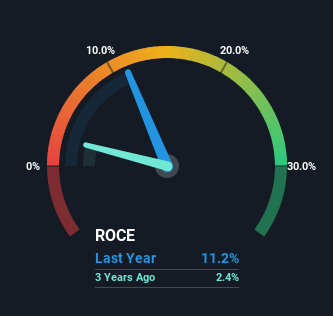
If we're looking to avoid a business that is in decline, what are the trends that can warn us ahead of time? A business that's potentially in decline often shows two trends, a return on capital employed (ROCE) that's declining, and a base of capital employed that's also declining. This indicates to us that the business is not only shrinking the size of its net assets, but its returns are falling as well. Having said that, after a brief look, Sapmer (EPA:ALMER) we aren't filled with optimism, but let's investigate further.
Understanding Return On Capital Employed (ROCE)
Just to clarify if you're unsure, ROCE is a metric for evaluating how much pre-tax income (in percentage terms) a company earns on the capital invested in its business. To calculate this metric for Sapmer, this is the formula:
Return on Capital Employed = Earnings Before Interest and Tax (EBIT) ÷ (Total Assets - Current Liabilities)
0.11 = €16m ÷ (€212m - €69m) (Based on the trailing twelve months to December 2022).
Therefore, Sapmer has an ROCE of 11%. In absolute terms, that's a satisfactory return, but compared to the Food industry average of 6.9% it's much better.
See our latest analysis for Sapmer

Historical performance is a great place to start when researching a stock so above you can see the gauge for Sapmer's ROCE against it's prior returns. If you'd like to look at how Sapmer has performed in the past in other metrics, you can view this free graph of past earnings, revenue and cash flow.
What Can We Tell From Sapmer's ROCE Trend?
In terms of Sapmer's historical ROCE movements, the trend doesn't inspire confidence. To be more specific, the ROCE was 20% five years ago, but since then it has dropped noticeably. And on the capital employed front, the business is utilizing roughly the same amount of capital as it was back then. Companies that exhibit these attributes tend to not be shrinking, but they can be mature and facing pressure on their margins from competition. If these trends continue, we wouldn't expect Sapmer to turn into a multi-bagger.
In Conclusion...
In summary, it's unfortunate that Sapmer is generating lower returns from the same amount of capital. Investors haven't taken kindly to these developments, since the stock has declined 42% from where it was five years ago. With underlying trends that aren't great in these areas, we'd consider looking elsewhere.
If you'd like to know more about Sapmer, we've spotted 5 warning signs, and 1 of them is a bit concerning.
While Sapmer isn't earning the highest return, check out this free list of companies that are earning high returns on equity with solid balance sheets.
New: Manage All Your Stock Portfolios in One Place
We've created the ultimate portfolio companion for stock investors, and it's free.
• Connect an unlimited number of Portfolios and see your total in one currency
• Be alerted to new Warning Signs or Risks via email or mobile
• Track the Fair Value of your stocks
Have feedback on this article? Concerned about the content? Get in touch with us directly. Alternatively, email editorial-team (at) simplywallst.com.
This article by Simply Wall St is general in nature. We provide commentary based on historical data and analyst forecasts only using an unbiased methodology and our articles are not intended to be financial advice. It does not constitute a recommendation to buy or sell any stock, and does not take account of your objectives, or your financial situation. We aim to bring you long-term focused analysis driven by fundamental data. Note that our analysis may not factor in the latest price-sensitive company announcements or qualitative material. Simply Wall St has no position in any stocks mentioned.
About ENXTPA:ALMER
Sapmer
Operates as a fishing company in South Africa, Northern America, Mauritius, Japan, Europe, China, and Réunion Island.
Low and overvalued.
Market Insights
Community Narratives



